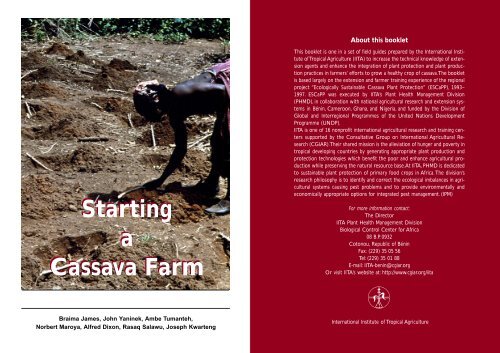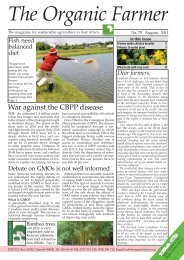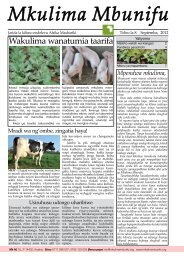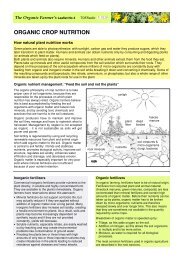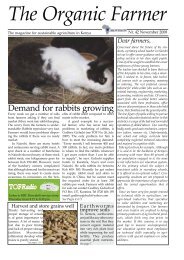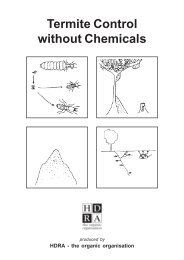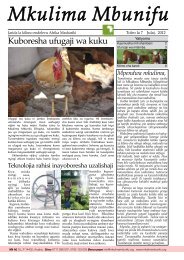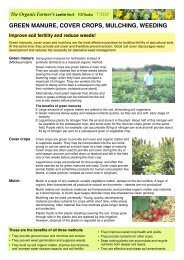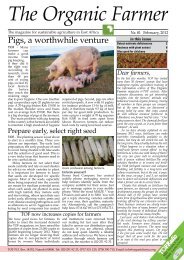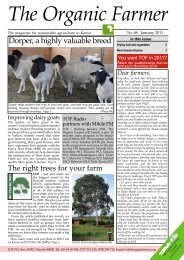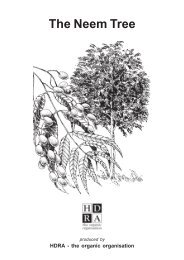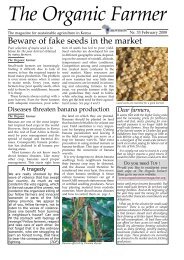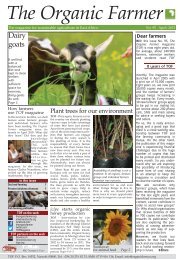Starting a cassava farm - Infonet-Biovision
Starting a cassava farm - Infonet-Biovision
Starting a cassava farm - Infonet-Biovision
You also want an ePaper? Increase the reach of your titles
YUMPU automatically turns print PDFs into web optimized ePapers that Google loves.
About this booklet<br />
<strong>Starting</strong><br />
a<br />
Cassava Farm<br />
This booklet is one in a set of field guides prepared by the International Institute<br />
of Tropical Agriculture (IITA) to increase the technical knowledge of extension<br />
agents and enhance the integration of plant protection and plant production<br />
practices in <strong>farm</strong>ers’ efforts to grow a healthy crop of <strong>cassava</strong>. The booklet<br />
is based largely on the extension and <strong>farm</strong>er training experience of the regional<br />
project “Ecologically Sustainable Cassava Plant Protection” (ESCaPP), 1993–<br />
1997. ESCaPP was executed by IITA’s Plant Health Management Division<br />
(PHMD), in collaboration with national agricultural research and extension systems<br />
in Bénin, Cameroon, Ghana, and Nigeria, and funded by the Division of<br />
Global and Interregional Programmes of the United Nations Development<br />
Programme (UNDP).<br />
IITA is one of 16 nonprofit international agricultural research and training centers<br />
supported by the Consultative Group on International Agricultural Research<br />
(CGIAR). Their shared mission is the alleviation of hunger and poverty in<br />
tropical developing countries by generating appropriate plant production and<br />
protection technologies which benefit the poor and enhance agricultural production<br />
while preserving the natural resource base. At IITA, PHMD is dedicated<br />
to sustainable plant protection of primary food crops in Africa. The division’s<br />
research philosophy is to identify and correct the ecological imbalances in agricultural<br />
systems causing pest problems and to provide environmentally and<br />
economically appropriate options for integrated pest management. (IPM)<br />
For more information contact:<br />
The Director<br />
IITA Plant Health Management Division<br />
Biological Control Center for Africa<br />
08 B.P. 0932<br />
Cotonou, Republic of Bénin<br />
Fax: (229) 35 05 56<br />
Tel: (229) 35 01 88<br />
E-mail: IITA-benin@cgiar.org<br />
Or visit IITA’s website at: http://www.cgiar.org/iita<br />
Braima James, John Yaninek, Ambe Tumanteh,<br />
Norbert Maroya, Alfred Dixon, Rasaq Salawu, Joseph Kwarteng<br />
International Institute of Tropical Agriculture
<strong>Starting</strong> a Cassava Farm<br />
IPM Field Guide for Extension Agents<br />
Braima James<br />
International Institute of Tropical Agriculture, Plant Health Management Division,<br />
Cotonou, Bénin<br />
John Yaninek<br />
International Institute of Tropical Agriculture, Plant Health Management Division,<br />
Cotonou, Bénin<br />
Ambe Tumanteh<br />
Institut de Recherche Agronomique et du Développement, Ekona, Cameroon<br />
Norbert Maroya<br />
Institut National des Recherches Agricoles du Bénin, Niaouli, Bénin<br />
Rasaq Salawu<br />
Ogun State Agricultural Development Project, Ogun State, Abeokuta, Nigeria<br />
Alfred Dixon<br />
International Institute of Tropical Agriculture, Crop Improvement Division, Ibadan,<br />
Nigeria<br />
© IITA 2000<br />
ISBN 978-131-173-8<br />
Printed in Nigeria by Wordsmithes Printers, Lagos<br />
Joseph A. Kwarteng<br />
Department of Agricultural Economics and Extension, University of Cape Coast,<br />
Cape Coast, Ghana
Contents<br />
What are the objectives of this guide ------------------------------------------- 4<br />
Introduction -------------------------------------------------------------------------- 4<br />
How do I select a good site for planting <strong>cassava</strong>------------------------------ 6<br />
How do I improve the soil for planting <strong>cassava</strong> ------------------------------- 8<br />
How do I select the best <strong>cassava</strong> varieties to plant -------------------------- 10<br />
How do I select healthy <strong>cassava</strong> stem cuttings -------------------------------12<br />
How do I best plant <strong>cassava</strong> -----------------------------------------------------16<br />
Summary ----------------------------------------------------------------------------- 19
<strong>Starting</strong> a Cassava Farm<br />
IPM Field Guide<br />
What are the objectives of this<br />
guide<br />
This field guide has been prepared to help you<br />
to:<br />
• select good sites for <strong>cassava</strong> <strong>farm</strong>s,<br />
• improve soils for good <strong>cassava</strong> growth,<br />
• select suitable <strong>cassava</strong> varieties for planting,<br />
and<br />
• select, prepare, and plant healthy <strong>cassava</strong><br />
stem cuttings.<br />
Introduction<br />
Cassava is one of the most common food<br />
crops grown and consumed in many parts of<br />
Africa. The crop grows well in various soil<br />
types and ecologies. It can be planted alone or<br />
in association with many other crops, like<br />
maize, groundnuts, vegetables, and rice. Growing<br />
<strong>cassava</strong> is not very labor intensive and usually<br />
requires 75–125 person-days per hectare<br />
from land preparation to harvesting. The storage<br />
roots can be harvested 9–18 months after<br />
planting. Under traditional <strong>farm</strong>ing practices,<br />
one can expect between 8 and 15 tonnes of<br />
storage roots per hectare of land planted only<br />
with <strong>cassava</strong>. Even under harsh environmental<br />
conditions <strong>cassava</strong> will provide some food<br />
when other crops fail. In most places there is a<br />
good market for <strong>cassava</strong>. The storage roots<br />
can be processed into various food products<br />
(Figures 1 and 2), and starch for domestic<br />
consumption, local, and/or export markets.<br />
Cassava leaves are nutritious vegetables (Figure<br />
3). The leaves and storage roots can also<br />
be used as animal feed. The stems can be sold<br />
as planting material.<br />
Figure 2:<br />
Gari preparation<br />
Figure 1:<br />
Assorted<br />
<strong>cassava</strong> products<br />
In order to grow a healthy crop of <strong>cassava</strong><br />
you will need to combine plant production<br />
and plant protection practices. These include<br />
site selection, soil improvement, variety and<br />
planting material selection, and planting and<br />
post-planting measures against weeds, pests,<br />
and diseases. The companion field guides on<br />
“Weed Control in Cassava Farms”, “Pest Control<br />
in Cassava Farms”, and “Disease Control<br />
in Cassava Farms” cover specific details of<br />
weeds, pests and diseases.<br />
Figure 3:<br />
Good <strong>cassava</strong> leaf<br />
harvest<br />
4<br />
5
<strong>Starting</strong> a Cassava Farm<br />
IPM Field Guide<br />
How do I select a good site for<br />
planting <strong>cassava</strong><br />
Cassava grows best in areas with deep and<br />
well-drained loamy soils, adequate rainfall, and<br />
warm and moist climatic conditions. The factors<br />
which guide you to determine if an area<br />
will be suitable for growing <strong>cassava</strong> include vegetation<br />
cover, soil texture and fertility, topography<br />
of land, and the field history of the area.<br />
Look for an area with thick vegetation<br />
cover: Sites with dense vegetation cover are<br />
likely to have fertile soils. The dense vegetation<br />
shades the soil from direct sunlight, reduces<br />
the amount of moisture that is lost from the<br />
soil through evaporation, and minimizes run-off<br />
water which may otherwise cause soil erosion.<br />
The dense vegetation also drops a lot of leaves<br />
which rot and add nutrients to the soil. In addition,<br />
decaying leaves encourage an increase in<br />
the number of earthworms and other small invertebrates<br />
in the soil, which in turn help to<br />
increase the air in the soil and make it better<br />
for growing <strong>cassava</strong>.<br />
Look for an area with good soil texture:<br />
The best soil for growing <strong>cassava</strong> is deep,<br />
loamy soil. Such soils are rich in nutrients, low<br />
in gravel, hold water well, and are easy to work<br />
or till. The way to tell if the soil is loamy is to<br />
moisten a small amount of it and try to shape<br />
it into a ball (Figure 4). If you press the ball and<br />
it falls apart, then your soil is loamy. If it feels<br />
gritty and you are not able to shape the<br />
moistened soil into a ball, then the soil is<br />
sandy. If you shape the soil into a ball, and the<br />
soil does not fall apart when pressed, then the<br />
soil contains a lot of clay and is a clayey soil.<br />
Sandy and clayey soils are not the most suitable<br />
soils for growing <strong>cassava</strong>.<br />
6<br />
Look for an area with fertile soil: Fertile<br />
soils usually have a dark color, for example,<br />
dark red or dark brown. The dark color shows<br />
that the soil has a lot of organic matter. If the<br />
soil looks gray and sometimes contains green<br />
or blue spots, it means that there is poor<br />
drainage and waterlogging. Do not grow <strong>cassava</strong><br />
on soils that get waterlogged.<br />
Look for an area with flat or gently sloping<br />
land: The best <strong>farm</strong>land for <strong>cassava</strong> is flat<br />
or gently sloping. Steep slopes are easily<br />
eroded and are therefore not very good areas<br />
for growing <strong>cassava</strong>. Valleys and depression areas<br />
are also not very suitable because they<br />
usually get waterlogged and do not allow <strong>cassava</strong><br />
roots to develop well. You may, however,<br />
plant early maturing <strong>cassava</strong> varieties on<br />
mounds or ridges in inland valleys during the<br />
dry season.<br />
Know the history of the site: Information<br />
such as how the land was previously used, and<br />
the types of weeds, diseases, and pests in the<br />
area, can help you in selecting a site for your<br />
<strong>cassava</strong> <strong>farm</strong>. Such information can help you<br />
to avoid a site with problems or make good<br />
plans for plant protection. Table 1 can be used<br />
to summarize the agronomic and <strong>cassava</strong><br />
plant protection history of a site.<br />
Figure 4: Testing soil texture by the “feel”<br />
method<br />
Table 1: Site description and history<br />
Site description<br />
Pests, diseases, and weeds<br />
Vegetation cover<br />
Cassava pests in the locality<br />
Scanty<br />
Cassava green mite<br />
Dense natural fallow<br />
Cassava mealybug<br />
Dense improved fallow<br />
Variegated grasshopper<br />
Spiraling whitefly<br />
Soil texture<br />
Cassava root scale<br />
Sandy<br />
Termites<br />
Loamy<br />
White scale insects<br />
Clayey<br />
Vertebrates<br />
Other (specify)<br />
Soil fertility<br />
Poor<br />
Good<br />
Topography<br />
Flat<br />
Hilly/steep slopes<br />
Depression area<br />
Previous crop<br />
Cassava<br />
Yam<br />
Sweetpotato<br />
Rice<br />
Maize<br />
Sorghum<br />
Cowpea/legumes<br />
Other (specify)<br />
For site description, tick (+) appropriate boxes.<br />
For pests, diseases and weeds, indicate importance of the problem as:<br />
+ = not serious<br />
++ = serious<br />
+++ = very serious<br />
Cassava diseases in the locality<br />
Cassava mosaic disease<br />
Cassava bacterial blight<br />
Cassava anthracnose disease<br />
Cassava bud necrosis<br />
Root rots<br />
Leaf spots<br />
Other (specify)<br />
Common weeds in the locality<br />
Spear grass<br />
Bermuda grass<br />
Guinea grass<br />
Feathery pennisetum<br />
Sedges<br />
Siam weed<br />
Giant sensitive weed<br />
Wild poinsettia<br />
Tridax<br />
Goat weed<br />
Parasitic weeds<br />
Other (specify)<br />
7
<strong>Starting</strong> a Cassava Farm<br />
IPM Field Guide<br />
How do I improve the soil for<br />
planting <strong>cassava</strong><br />
If you do not select a good site for growing<br />
<strong>cassava</strong> you may have to spend a lot of time and<br />
materials to improve the soil. Cassava plants on<br />
good soils grow vigorously and are able to<br />
withstand some damage by pests and diseases.<br />
The following are examples of cultural practices<br />
you can use to improve soil properties.<br />
Manure your <strong>farm</strong>: At land preparation, you<br />
can add organic manure to the soil to increase<br />
soil nutrients, improve soil structure, and improve<br />
the ability of the soil to hold water. Organic<br />
manure can be in the form of green manure<br />
or other dead plant or animal manure. In<br />
green manuring, plant foliage (fresh leaves and<br />
young green stems) is ploughed into the soil.<br />
Green manure improves soil properties as the<br />
foliage rots. Egusi melon and leguminous crops,<br />
for example, groundnuts and beans, make<br />
good green manure. Inorganic fertilizers can<br />
also be applied to increase soil fertility. For<br />
example, in southeast Nigeria, the recommended<br />
rate for NPK application is 400 kg.<br />
per hectare of land.<br />
Prepare suitable seedbeds: Cassava fields<br />
on hilly sites with steep slopes are frequently<br />
eroded. The erosion will be severe if the leaf<br />
canopy of <strong>cassava</strong> plants is not thick enough to<br />
cover the ground against rain splashes. This<br />
happens in young <strong>cassava</strong> <strong>farm</strong>s and if the varieties<br />
have a tall and less branching habit (Figure<br />
5). If you cannot avoid growing <strong>cassava</strong> on<br />
steep slopes you can grow <strong>cassava</strong> varieties<br />
with early, low, and much branching habit (Figure<br />
6) to cover the ground quickly and properly<br />
against rain erosion. You can also make<br />
ridges across the slopes and mulch the ridges<br />
to reduce erosion.<br />
Mulch <strong>cassava</strong> seedbeds: Mulching involves<br />
covering the soil surface with plant materials.<br />
Mulching improves the fertility of the soil, increases<br />
the ability of the soil to hold sufficient<br />
water for plant growth, and reduces erosion<br />
and weed problems. Mulching <strong>cassava</strong> seedbeds<br />
is especially valuable when growing <strong>cassava</strong><br />
in dry areas and on slopes.<br />
Mulching requires very large amounts of plant<br />
foliage. Dead plant foliage can be used as<br />
“dead mulch”. Sources of good dead mulch<br />
are foliage from alley crops, leguminous plants,<br />
rice husk, coffee hull and general crop and<br />
weed residues. Avoid using weed residues<br />
containing weed seeds, rhizomes, stolons, or<br />
tubers as mulch because these can increase<br />
weed problems on your <strong>farm</strong>. Straws of maize<br />
and guinea grass (Figure 7) are bad mulch materials<br />
because they take too long to rot and<br />
use up soil nitrogen as they do so.<br />
You can grow plants as “live mulches”. For example,<br />
egusi melon (a food crop) planted at<br />
very close spacing on <strong>cassava</strong> seedbeds is a<br />
good live mulch. Nonfood crops can also be<br />
used as live mulches, but these are normally<br />
grown as improved fallow plants. For example,<br />
during fallow periods you can grow Mucuna<br />
pruriens var. utilis on land you have selected for<br />
growing <strong>cassava</strong> in the next season (Figure 8).<br />
Mucuna pruriens var. utilis is, however, a fire hazard<br />
in the dry season when its foliage dries.<br />
Plant <strong>cassava</strong> in association with other<br />
crops: Appropriate intercrops improve soil<br />
properties in a manner similar to live mulches.<br />
Crops that are commonly intercropped with<br />
<strong>cassava</strong> are maize, rice, legumes, and vegetables.<br />
Legumes, for example, cowpea and<br />
groundnuts, are a particularly good intercrop<br />
because these plants make and release nutrients<br />
into the soil.<br />
Figure 5: Cassava variety with late,<br />
high, and less branching habit<br />
Figure 7: Shoots of guinea grass,<br />
Panicum maximum<br />
Figure 6: Cassava variety with early, low, and<br />
much branching habit<br />
Figure 8: Live mulch of Mucuna on fallow land<br />
8<br />
9
<strong>Starting</strong> a Cassava Farm<br />
IPM Field Guide<br />
How do I select the best<br />
<strong>cassava</strong> varieties to plant<br />
The best <strong>cassava</strong> varieties are those that are<br />
liked by consumers, grow fast, give good yields,<br />
store well in the soil and are tolerant to major<br />
pests, and diseases. The particular variety chosen<br />
by a <strong>farm</strong>er depends on her/his objectives<br />
for planting the crop, and the factors looked<br />
for in selecting <strong>cassava</strong> varieties usually include<br />
the following.<br />
Look for varieties with high dry matter<br />
and good food quality: Cassava storage<br />
roots consist mainly of water and dry matter.<br />
The dry matter is mainly starch and a little bit<br />
of fiber. The percentage of dry matter in the<br />
roots determines the quantity and quality of<br />
the products obtained after the roots are<br />
processed. Cassava varieties whose storage<br />
roots have 30% or more dry matter are said<br />
to have high dry matter content. Such varieties<br />
produce good quality products and are<br />
profitable for growers and market women.<br />
Look for varieties with good mealiness:<br />
Mealiness refers to the cooking ability of <strong>cassava</strong><br />
storage roots without processing. Mealy varieties<br />
are commonly called “sweet” <strong>cassava</strong> whilst<br />
non-mealy varieties are called “bitter” <strong>cassava</strong>.<br />
Bitter <strong>cassava</strong> requires processing before consumption<br />
and this is related to the total cyanide<br />
content (referred to as cyanogenic potential,<br />
CNP) in the storage roots. The higher the CNP<br />
of a variety, the greater the need to process its<br />
storage roots for safe consumption. If <strong>cassava</strong><br />
leaves will be eaten, you can also consider the<br />
cooking quality of the leaves.<br />
Look for varieties that bulk early: Bulking<br />
refers to the swelling of the storage roots as<br />
they are filled with stored food. Varieties that<br />
bulk early are better able to offset losses in<br />
storage root yield caused by weed competition,<br />
leaf-feeding pests, and disease than late<br />
maturing varieties.<br />
Look for varieties with good ground<br />
storability: Ground storability is the ability<br />
of the mature <strong>cassava</strong> storage roots to stay in<br />
the ground for a long time without getting<br />
spoiled. Good ground storability prolongs the<br />
period over which the crop can be harvested.<br />
This reduces the duration of postharvest<br />
storage problems of fresh roots.<br />
Look for varieties that are tolerant to<br />
weeds, pests, and diseases: Some <strong>cassava</strong><br />
varieties tolerate weeds, pests, and diseases<br />
better than others. In selecting a variety to<br />
grow, it is advisable to consider how well the<br />
variety can compete with weeds, and resist<br />
pests and diseases. For example, if weeds are a<br />
problem you can look for adapted varieties<br />
which branch early, low, and often (Figure 6).<br />
Such varieties are able to develop a lot of<br />
branches and leaves quickly to shade the<br />
ground and prevent weeds from growing vigorously<br />
and becoming a problem. You can also<br />
find out if the variety has other features you<br />
may want.<br />
Table 2 lists some features of <strong>cassava</strong> varieties<br />
commonly grown in West and Central Africa.<br />
Scientists and extension agents can prepare a<br />
list similar to Table 2 for the <strong>cassava</strong> varieties<br />
growing in the locality.<br />
Table 2: Some features of common <strong>cassava</strong> varieties in West and Central Africa<br />
Expression of selected features<br />
Variety<br />
Tolerance to<br />
CBB<br />
Tolerance to<br />
CMD<br />
Tolerance to<br />
CGM<br />
Weed<br />
suppression<br />
Ground<br />
storability<br />
Cyanogenic<br />
potential<br />
% dry matter<br />
Yield<br />
potential<br />
IITA<br />
TMS 4(2)1425 High High Low Good Good Moderate Moderate Good<br />
TMS 30572 High High Moderate Moderate Good Moderate Good Good<br />
Benin<br />
BEN 86052 High High Low Poor Moderate Good Good Poor<br />
RB 89509 Moderate Moderate Low Good Poor Poor Good Moderate<br />
Cameroon<br />
8017 High High Moderate Poor Good Moderate Moderate Moderate<br />
8034 High High Moderate Poor Good Moderate Moderate Moderate<br />
Ghana<br />
"Afisiafi" High High Moderate Moderate Good Moderate Good Good<br />
"Abasa fitaa" High High Low Good Good Moderate Moderate Good<br />
Nigeria<br />
MS 6 High High Low Poor Poor Good Good Moderate<br />
NR 8082 High High High Moderate Good Good Good Good<br />
CGM = Cassava green mite<br />
CMD = Cassava mosaic disease<br />
CBB = Cassava bacterial blight<br />
Source: IITA, INRAB-Benin, MoFA-CSD Ghana, IRAD-Cameroon, and NRCRI-Nigeria<br />
10<br />
11
<strong>Starting</strong> a Cassava Farm<br />
IPM Field Guide<br />
How do I select healthy <strong>cassava</strong><br />
stem cuttings<br />
<strong>cassava</strong> bacterial blight, <strong>cassava</strong> anthracnose<br />
disease, and <strong>cassava</strong> bud necrosis.<br />
The most common sources of <strong>cassava</strong> stem<br />
planting material are <strong>farm</strong>ers’ own <strong>farm</strong>s. Occasionally,<br />
<strong>cassava</strong> stem cuttings are sold at village<br />
and town markets. Researchers and extension<br />
agents sometimes provide their contact<br />
<strong>farm</strong>ers with <strong>cassava</strong> stem cuttings. Many<br />
<strong>cassava</strong> pests and diseases are stem-borne<br />
and spread by distribution, sale, and planting of<br />
infested or diseased stem cuttings. By planting<br />
healthy stem cuttings, you can greatly reduce<br />
the spread and damage caused by these <strong>cassava</strong><br />
pests and diseases. The following guidelines<br />
will assist you to avoid unhealthy stem<br />
cuttings and to select healthy planting material<br />
for a healthy crop of <strong>cassava</strong>.<br />
Look for healthy <strong>cassava</strong> plants: Select<br />
healthy <strong>cassava</strong> plants in the <strong>farm</strong>. Healthy <strong>cassava</strong><br />
plants have robust stems and branches,<br />
lush foliage, and minimal stem and leaf damage<br />
by pests and diseases. From each plant select<br />
the middle brown-skinned portions of stems<br />
as stem cuttings. These parts sprout and ensure<br />
plant vigor better than the top green<br />
stem portions. Stem cuttings taken from the<br />
top green portions of stems or extreme top<br />
and bottom of stored stems are unsuitable.<br />
They will dehydrate quickly, produce unhealthy<br />
sprouts, and are easily damaged by<br />
pests and diseases.<br />
Avoid plants with pests and diseases: In<br />
selecting <strong>cassava</strong> plants as sources of stem<br />
cuttings, you should avoid those infected with<br />
these pests and diseases. The common stemborne<br />
<strong>cassava</strong> pests and diseases are <strong>cassava</strong><br />
mealybug, <strong>cassava</strong> green mite, spiraling whitefly,<br />
white scale insect, <strong>cassava</strong> mosaic disease,<br />
The <strong>cassava</strong> mealybug, Phenacoccus manihoti,<br />
occurs on <strong>cassava</strong> leaves, shoot tips, petioles,<br />
and stems. The mealybugs are covered<br />
with white waxy secretions. Cassava mealybug<br />
damage symptoms include shortened internode<br />
lengths, compression of terminal<br />
leaves together into “bunchy tops” (Figure 9),<br />
distortion of stem portions, defoliation, and<br />
“candlestick” appearance of shoot tip. The insects<br />
survive on <strong>cassava</strong> stems and leaves and<br />
are easily carried to new fields in this way.<br />
The <strong>cassava</strong> green mite, Mononychellus<br />
tanajoa, occurs on the undersurfaces of young<br />
leaves, green stems, and axilliary buds of <strong>cassava</strong>.<br />
The mites appear as yellowish green<br />
specks to the naked eye. Mites survive on <strong>cassava</strong><br />
stems and leaves and are easily carried to<br />
new fields in this way. Cassava green mite<br />
damage symptoms include yellow chlorotic<br />
leaf spots (like pin pricks) on the upper leaf<br />
surfaces, narrowed and smaller leaves (Figure<br />
10), “candlestick” appearance of the shoot tip,<br />
and stunted <strong>cassava</strong> plants.<br />
The spiraling whitefly, Aleurodicus dispersus,<br />
damages <strong>cassava</strong> by sucking sap from the leaves.<br />
Colonies of the insect occur on the undersurfaces<br />
of <strong>cassava</strong> leaves and are covered with<br />
white waxy secretions similar to those of the<br />
<strong>cassava</strong> mealybug. Spiraling whitefly eggs occur<br />
in spiral patterns of wax tracks, mostly on the<br />
undersurfaces of leaves. Symptoms of whitefly<br />
damage are black sooty mold on the upper leaf<br />
surfaces, petioles, and stems (Figure 11), and<br />
premature leaf fall of older leaves. The insects<br />
survive on <strong>cassava</strong> leaves and stems and are<br />
easily carried to new fields in this way.<br />
Figure 9: Cassava shoot tip with<br />
“bunchy top” caused by <strong>cassava</strong><br />
mealybug<br />
Figure 11: Cassava stem and leaves<br />
blackened under attack by spiraling<br />
whitefly<br />
Figure 10: Cassava shoot tip with<br />
small and narrow leaves caused by<br />
<strong>cassava</strong> green mite<br />
Figure 12: Cassava white scale on<br />
<strong>cassava</strong> stem<br />
12<br />
13
<strong>Starting</strong> a Cassava Farm<br />
IPM Field Guide<br />
The white scale, Aonidomytilus albus, covers<br />
<strong>cassava</strong> stem surfaces with conspicuous white<br />
waxy secretions (Figure 12). The insect sucks<br />
sap from the stem and dehydrates it. Stem<br />
cuttings derived from affected stem portions<br />
normally do not sprout. The insects survive<br />
on <strong>cassava</strong> stems and leaf petioles and are easily<br />
carried to new fields in this way.<br />
Cassava mosaic disease is caused by a virus<br />
which occurs inside <strong>cassava</strong> stems. Symptoms<br />
of <strong>cassava</strong> mosaic disease damage are<br />
patches of normal green leaf color mixed with<br />
light green and yellow chlorotic areas in a<br />
mosaic pattern (Figure 13). Generally, plants<br />
with these symptoms should be avoided as<br />
sources of stem planting material. However,<br />
the disease is very common in Africa and it is<br />
sometimes difficult to find <strong>cassava</strong> plants that<br />
are completely free from the disease. You can,<br />
however, reduce <strong>cassava</strong> mosaic disease problems<br />
by selecting stem cuttings from <strong>cassava</strong><br />
stem branches and not from the main stems.<br />
Stem cuttings from the branches are more<br />
likely to sprout into disease-free plants than<br />
stem cuttings from the main stems.<br />
Cassava anthracnose disease is caused by<br />
a fungus which occurs on the surface of <strong>cassava</strong><br />
stems. The disease damage symptoms are<br />
cankers (“sores”) on the stem and bases of<br />
leaf petioles (Figure 15). The disease reduces<br />
the sprouting ability of stem cuttings.<br />
Cassava bud necrosis is caused by a fungus<br />
which grows on the surface of <strong>cassava</strong> stems<br />
covering the axilliary buds or the “eyes” of<br />
stem cuttings (Figure 16). The affected buds<br />
die, and the sprouting ability of stem cuttings<br />
is reduced.<br />
Figure 13: Cassava plant with <strong>cassava</strong><br />
mosaic disease<br />
Figure 14: Leaf blighting and wilting<br />
caused by <strong>cassava</strong> bacterial blight<br />
Cassava bacterial blight is caused by a bacterium<br />
which occurs inside <strong>cassava</strong> stems. The<br />
disease damage symptoms are angular leaf<br />
spots on the under leaf surfaces, leaf blighting<br />
and wilting (Figure 14), gum exudate on the<br />
stems, and shoot tip die-back. Avoid selecting<br />
stem cuttings from plants with these symptoms.<br />
p<br />
Figure 15: Cankers of <strong>cassava</strong><br />
anthracnose disease on stem<br />
Figure 16: Fungal patch (arrow) of<br />
bud necrosis disease<br />
14<br />
15
<strong>Starting</strong> a Cassava Farm<br />
IPM Field Guide<br />
How do I best plant <strong>cassava</strong><br />
The important factors to consider when<br />
planting <strong>cassava</strong> are time of year, land tillage<br />
methods, seedbed type and preparation, and<br />
preparation, handling, and planting mode of<br />
stem cuttings.<br />
Select suitable planting dates: You should<br />
try to plant <strong>cassava</strong> early, at the beginning of<br />
the rainy season. This ensures healthy sprouting<br />
and good crop establishment which helps<br />
the plant to better withstand damage by dry<br />
season pests like the <strong>cassava</strong> green mite, <strong>cassava</strong><br />
mealybug, and termites. Late planting at<br />
the end of wet season exposes the crop to<br />
severe damage by these pests as the dry season<br />
progresses. However, planting date recommendations<br />
should fit within local <strong>farm</strong>ing<br />
calendars and <strong>farm</strong>ers’ choice of crops to enhance<br />
their adoption.<br />
Use suitable land and seedbed preparation<br />
methods: In <strong>cassava</strong> cultivation, land is<br />
usually tilled to loosen up the soil, improve<br />
soil drainage, make it easy for roots to develop,<br />
and promote healthier storage root development.<br />
Mounds and ridges are commonly<br />
made to gather top soil material for <strong>cassava</strong><br />
root development, limit prolonged contact<br />
between the storage roots and stagnant water,<br />
and protect storage roots from rodent<br />
and bird pests.<br />
The soil texture at the site you select for <strong>cassava</strong><br />
cultivation will be an important factor in<br />
determining the level of tillage and type of<br />
seedbeds required for your <strong>cassava</strong> <strong>farm</strong>. In<br />
deep loamy soils, tillage may be essential but it<br />
does not matter which seedbed type is<br />
adopted and <strong>cassava</strong> can be planted on the flat<br />
(Figure 17), mounds (Figure 18), or ridges (Figure<br />
19).<br />
However, if the loamy soil is shallow and <strong>cassava</strong><br />
is planted on the flat, the storage roots<br />
will quickly reach hard ground or rocks giving<br />
poor yields. In sandy soils, minimum tillage and<br />
planting <strong>cassava</strong> on the flat are appropriate<br />
because the soil is sufficiently loose to allow<br />
for faster drainage and normal storage root<br />
development. At sites where the sandy soil<br />
gets waterlogged, it is however better to make<br />
ridges or mounds than to plant on the flat. In<br />
clayey and poorly drained soils, tillage and<br />
planting of <strong>cassava</strong> on mounds or ridges are<br />
also essential to limit the effects of waterlogging.<br />
Prepare and handle stem cuttings properly:<br />
When cutting up <strong>cassava</strong> stems into<br />
stem cuttings for planting, make sure each<br />
cutting is at least 20–25 cm long and has about<br />
5–8 nodes. You should handle cuttings<br />
carefully during transportation to prevent<br />
bruises and damage to the nodes. This can be<br />
done by packing them on cushions of dry<br />
leaves.<br />
Sometimes, when planting material is slightly<br />
infested with <strong>cassava</strong> green mites, <strong>cassava</strong><br />
mealybugs, and other stem-borne pests, the<br />
stem cuttings can be treated by immersing<br />
them in heated water for 5–10 minutes just<br />
before planting. This treatment will kill pests<br />
on the surface of the cuttings. You can prepare<br />
the heated water by mixing equal volumes of<br />
boiling and cold water. Alternatively, you can<br />
dip the stem cuttings into a dilute pesticide<br />
solution (for example, 1% Rogor solution) to<br />
kill stem-borne pests. You can also reduce the<br />
incidence of <strong>cassava</strong> anthracnose and other<br />
Figure 18:<br />
Cassava growing<br />
on mounds<br />
Figure 17:<br />
Planting<br />
<strong>cassava</strong> on<br />
the flat<br />
Figure 19:<br />
Cassava growing<br />
on ridges<br />
16<br />
17
<strong>Starting</strong> a Cassava Farm<br />
IPM Field Guide<br />
stem-borne fungal diseases if a solution of<br />
pesticide (for example, Décis) and fungicide<br />
(for example, Benlate) is used. If pesticides are<br />
to be used, you should consult the label for<br />
guidelines on their application methods and<br />
how to avoid personal and environmental hazards<br />
associated with their use.<br />
Adopt suitable planting mode: In order<br />
to get the best sprouting and growth from<br />
<strong>cassava</strong> stem cuttings, it is important to plant<br />
them properly. Cassava stem cuttings may be<br />
planted vertically, at an angle, or horizontally.<br />
When planted vertically, the storage roots<br />
develop deeper in the soil, more closely together,<br />
and are more difficult to harvest by<br />
pulling. Vertical planting is best in sandy soils.<br />
In such soils, plant stem cuttings vertically<br />
with 2/3 of the length of the cutting below<br />
the soil. When planted horizontally, the storage<br />
roots develop more closely to the surface<br />
and are more likely to be exposed and<br />
attacked by rodent and birds. Also, in horizontal<br />
planting several weak stems develop<br />
from the stem cutting. Horizontal planting,<br />
however, has the advantage of killing insect<br />
and mite pests which occur on the surface of<br />
stem cuttings. In loamy soil it is probably best<br />
to plant at an angle.<br />
The spacing between plants will depend on<br />
whether you are growing <strong>cassava</strong> alone (sole<br />
crop) or with other crops (intercropping). If<br />
<strong>cassava</strong> is being grown alone, plant 1 meter<br />
apart from each other. If <strong>cassava</strong> is being<br />
grown as an intercrop, consider the branching<br />
habit of both the <strong>cassava</strong> and the other crops<br />
and make sure there is enough space for the<br />
plants. You should also make sure there is<br />
enough space for you to work between the<br />
plants during weeding and other activities.<br />
18<br />
Summary<br />
• To select a good site for a <strong>cassava</strong> <strong>farm</strong>, look for an area with dense vegetation<br />
cover, good soil texture, fertile soils, and flat or gently sloping land; also examine the<br />
field history to plan for plant protection measures.<br />
• Improve the soil by manuring, mulching, and intercropping to encourage <strong>cassava</strong><br />
plants to grow vigorously and offset damage by <strong>cassava</strong> diseases.<br />
• To select good <strong>cassava</strong> varieties for planting, look for varieties with high dry matter,<br />
good mealiness, good ground storability and which are well adapted to your area;<br />
the variety should also bulk early and be easy to process.<br />
• To select healthy <strong>cassava</strong> stem cuttings, choose healthy <strong>cassava</strong> plants as sources of<br />
planting materials; use stem cuttings taken from the middle, brown portions of the<br />
stem and free of stem-borne pests and diseases.<br />
• To prepare <strong>cassava</strong> stem cuttings for planting, cut each stem cutting to a length of<br />
at least 20–25 cm; use stem cuttings with about 5–8 nodes; treat stem cuttings<br />
slightly infested with stem-borne pests by immersing them in heated water for 5–<br />
10 minutes, dipping them into a dilute pesticide solution, or by planting them horizontally.<br />
• To plant <strong>cassava</strong> stem cuttings properly consider the type of soil; prepare ridges<br />
and mounds in areas where soil gets waterlogged; use minimum tillage in sandy soil;<br />
plant <strong>cassava</strong> stem cuttings vertically in sandy soil; plant <strong>cassava</strong> stem cuttings at an<br />
angle in loamy soil; plant <strong>cassava</strong> stem cuttings 1 meter apart from each other in<br />
sole cropping; and in <strong>cassava</strong> intercrops make sure there is enough space for the<br />
plants.<br />
19
<strong>Starting</strong> a Cassava Farm<br />
Acknowledgements<br />
Special thanks to the United Nations Development Programme and the Austrian government<br />
which provided funds, and to the following institutions which provided materials, information and<br />
services for the production of the set of <strong>cassava</strong> IPM field guides:<br />
• Agricultural Development Programmes (ADPs) in Abia, Akwa Ibom, Anambra,<br />
Benue, Cross Rivers, Rivers, Delta, Edo, Enugu, Imo, Kogi, Kwara, Ogun, Ondo, Osun,<br />
Oyo, and Plateau State Governments, Nigeria<br />
• Centre d’Action Régionale pour le Développement Rural (CARDER), Bénin<br />
• Centro International de Agricultura Tropical (CIAT), Cali, Colombia<br />
• Crop Services Department (CSD), Department of Agricultural Extension Services<br />
(DAES), and Plant Protection and Regulatory Services Department (PPRSD), Ministry<br />
of Food and Agriculture, Ghana<br />
• Federal University of Technology, Owerri, Nigeria<br />
• Fourah Bay College, University of Sierra Leone, Freetown, Sierra Leone<br />
• IITA Eastern and Southern African Regional Centre (ESARC), Uganda<br />
• Institut de Recherche Agronomique et du Développement (IRAD), Cameroon<br />
• Institut National de Recherche Agronomique du Bénin (INRAB), Bénin<br />
• National Root Crops Research Institute (NRCRI), Umudike, Nigeria,<br />
• Rural Training Centre (RTC, Presbyterian Church) in Fonta and Kumba, Cameroon<br />
• Sasakawa Global 2000, Bénin<br />
• Service de Protection des Végétaux et du Contrôle Phytosanitaire (SPVC), Bénin<br />
• Southern African Root Crops Research network (SARRNET), Malawi<br />
• University of Agriculture, Abeokuta, Nigeria<br />
• University of Buea, Buea, Cameroon<br />
• University of Cape Coast, Cape Coast, Ghana<br />
20


